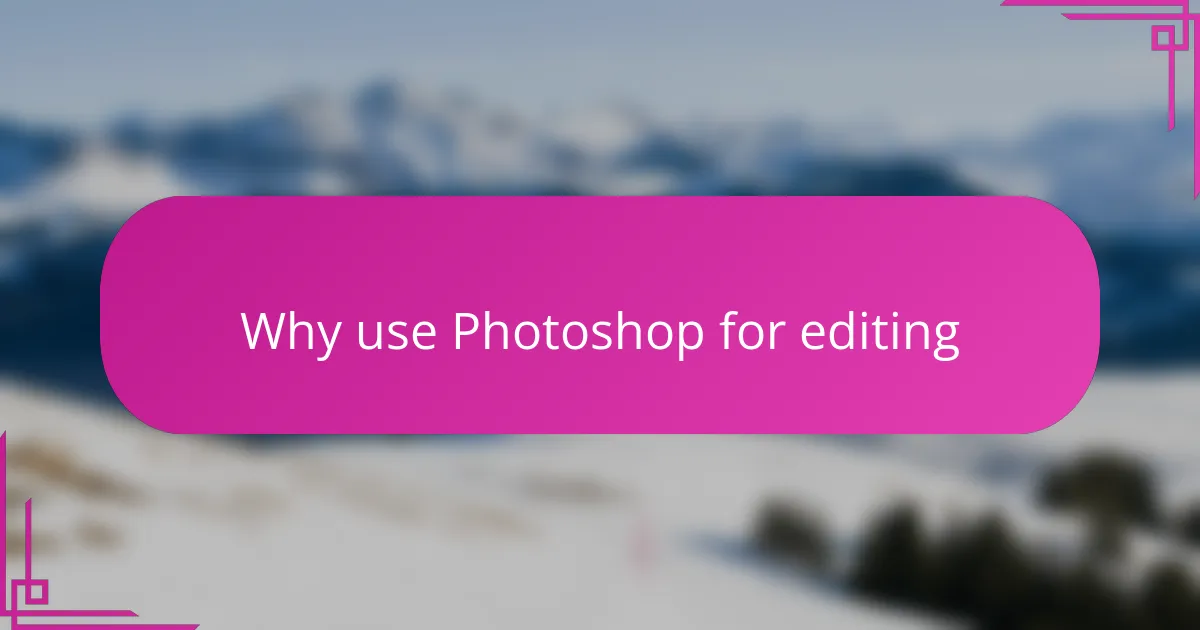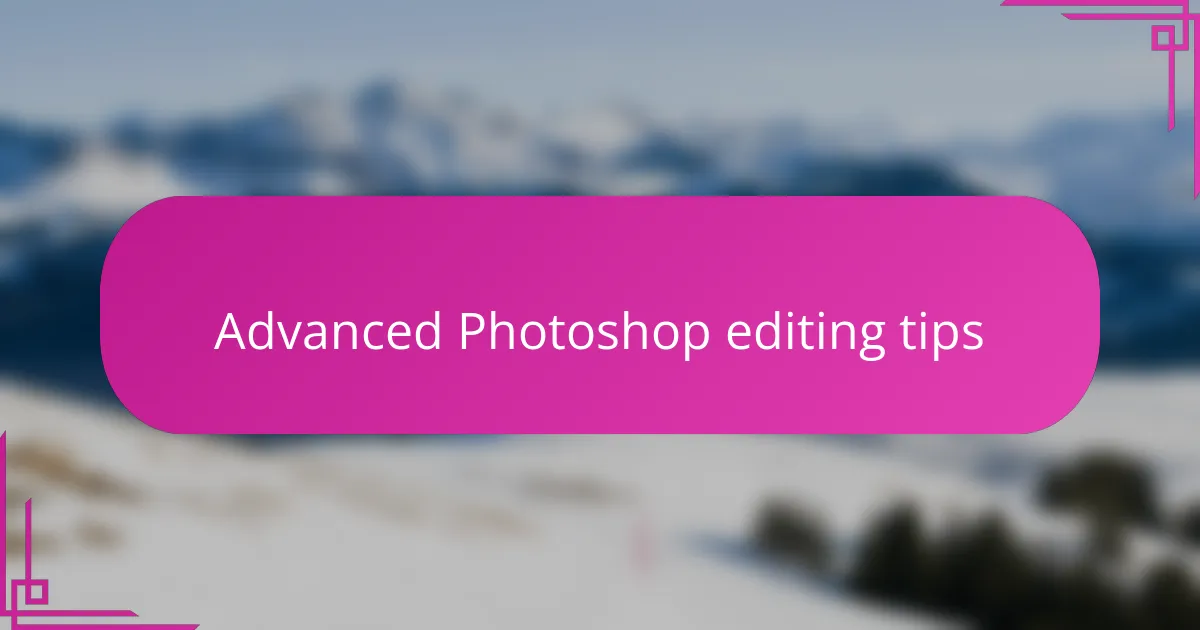Key takeaways
- Photo enhancement improves image clarity and emotional impact by adjusting brightness, contrast, and color balance.
- Photoshop is favored for its precise control, versatility, and non-destructive editing tools that encourage creative experimentation.
- Common photo enhancement techniques include brightness and contrast adjustments, color correction, and sharpening for clarity.
- It’s important to avoid over-enhancement and maintain the original mood of the photo to preserve its storytelling essence.

What is photo enhancement
Photo enhancement, to me, is about bringing out the best in an image—making it clearer, more vibrant, and emotionally impactful. Have you ever looked at a photo and felt it didn’t quite capture what you saw with your own eyes? That’s where enhancement steps in.
It involves adjusting elements like brightness, contrast, color balance, and sharpness to breathe new life into a snapshot. Sometimes, a subtle tweak can transform a dull photo into something that tells a stronger story or evokes a deeper feeling.
Why do we enhance photos? Because every image deserves to shine in its own way. I’ve often found that this process allows me to connect more deeply with my work, turning simple moments into lasting memories.

Why use Photoshop for editing
Photoshop has always been my go-to tool because it offers unparalleled control over every detail of an image. Have you ever wanted to fix something tiny yet crucial, like a stray hair or a distracting shadow? Photoshop lets me do that with precision, which makes a huge difference in the final result.
What really draws me in is Photoshop’s versatility. Whether I need to adjust colors, sharpen details, or blend multiple layers, it handles everything in one place. This all-in-one approach saves me time and keeps my creative flow uninterrupted.
And let’s not forget the sheer power of Photoshop’s tools—like layers, masks, and filters—that allow for non-destructive editing. I love knowing that I can experiment freely, trying out bold ideas without worrying about ruining the original photo. It’s like having a creative safety net.

Essential Photoshop tools overview
When I first dove into Photoshop, the toolbox felt overwhelming. But I quickly realized that a handful of core tools—the Brush, Healing Brush, and Crop—became my trusty companions. These essentials let me fix imperfections, reshape composition, and add subtle touches that make an image truly pop.
Have you ever caught yourself obsessing over tiny details like stray pixels or uneven skin tones? I know I have. That’s where the Clone Stamp and Spot Healing Brush come in handy, letting me erase distractions almost magically without losing the photo’s natural feel.
Another game-changer for me has been working with Adjustment Layers. Instead of permanently changing pixels, these layers let me tweak brightness, contrast, and color with the freedom to fine-tune endlessly. It’s like painting with light and mood, giving each photo its own unique emotion.

Basic photo enhancement techniques
Basic photo enhancement often starts with mastering simple adjustments like brightness and contrast. I remember the first time I brightened a shadowy portrait—it suddenly felt more alive, revealing details that were hidden before. Have you noticed how a slight contrast boost can give your photo that extra punch without overdoing it?
Color correction is another fundamental step. I like to ask myself whether the colors look natural or if they need a nudge toward warmth or coolness. Sometimes just shifting the color balance by a few ticks transforms the mood entirely, making a sunset feel warmer or a snowy scene crisper.
Sharpening is where images gain clarity, but it’s a delicate dance. Too much, and details turn harsh; too little, and everything feels soft. I often zoom in to fine-tune the sharpness, ensuring textures pop while the photo keeps its natural grace. Have you experimented with sharpening yet? It’s surprising how much it can elevate a shot.

Advanced Photoshop editing tips
One advanced tip I rely on is using layer masks to refine edits without permanently altering the image. By painting with black or white on a mask, I can selectively show or hide adjustments, which feels like having complete control over every pixel. Have you tried this? It’s empowering to dial in changes precisely where you want them, preserving the photo’s integrity.
Another technique I find invaluable is blending modes combined with adjustment layers. Switching a layer’s blend mode can create subtle or dramatic effects—like soft light to boost contrast or overlay to intensify colors. It took me a while to get comfortable experimenting here, but once I did, the creative possibilities opened wide. Would you believe this method helped me save a seemingly dull landscape image by adding a rich, moody glow?
Lastly, I often use the Camera Raw filter for global fine-tuning and localized corrections within Photoshop itself. It’s like stepping back into the raw development process, but with all the power of Photoshop right under my fingertips. Tweaking clarity, dehaze, or even selectively sharpening areas makes a huge difference, especially when you want to keep the look natural and dynamic. If you haven’t explored this filter yet, it’s definitely worth a try.

My personal Photoshop workflow
When I sit down to enhance a photo in Photoshop, my workflow always begins with assessing the image’s story. I ask myself, what mood or feeling do I want to bring forward? This reflection guides every brush stroke and adjustment, making the process more intuitive than mechanical.
Next, I organize my layers meticulously. Starting with basic adjustments like exposure and color balance on separate layers protects my work and lets me experiment freely. It’s a habit I picked up early on because it prevents that sinking feeling of losing hours of effort to a single wrong move.
Finally, I dive into detail work—using masks and healing tools to gently remove distractions while preserving the natural essence of the shot. It’s almost meditative for me, watching imperfections vanish without erasing the soul of the image. Have you ever found yourself immersed in that satisfying rhythm of fine-tuning every pixel? For me, that’s where the magic truly happens.

Common photo enhancement mistakes to avoid
One mistake I see often is going overboard with enhancements. Have you ever cranked up the saturation or contrast so much that the photo starts to look unnatural or even cartoonish? I’ve definitely been there, and it’s tempting to push every slider to the max, but restraint usually creates a more authentic and pleasing image.
Another pitfall is ignoring the photo’s original mood and story. Sometimes, in my early edits, I enhanced colors or sharpness without thinking about what feeling the photo was meant to convey. It felt like losing the soul of the picture. To avoid this, I ask myself if my changes enhance the story or distract from it.
Precision is key, yet rushing is a common foe. I remember trying to speed through retouching and ending up with harsh edges or repeated patterns that screamed “Photoshop.” Taking time with layer masks and healing brushes makes a world of difference. Have you ever zoomed in closely only to find those tiny flaws that spoil the entire image? That’s why patience pays off in the end.